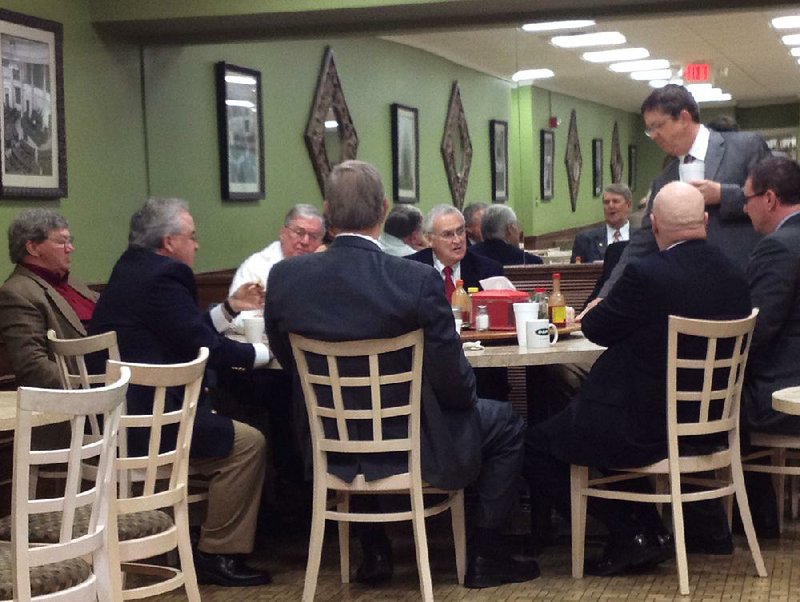LITTLE ROCK — Correction: Gene Tyer took over the operation of the Capitol cafeteria in 1947. His last name was misspelled in this article.
The Capitol Cafe, tucked away in the basement of Arkansas’ Statehouse, is a quiet, unassuming dining nook. The low-key atmosphere could easily lead one to believe it’s just an everyday, ordinary cafeteria.
From its beige tile floors to the green and wood paneled walls, this place is understated with only the subtlest of accents - framed black and white photographs of locales around the Capitol and a frosted glass divider between the serving and dining areas, etched with images of the Capitol’s dome.
But there is no telling how much shaping of our state’s past, present and future has taken place here, support garnered with a handshake or just the pass of the salt and pepper between bites of a generous plate full of chicken-fried chicken, great Northern beans, collard greens and cornbread.
Upstairs, Arkansas’ lawmakers debate weighty issues like abortion and allowing concealed guns in churches. But here in the Capitol Cafe, food has the floor with lawmakers casting their votes on menu choices instead of political issues.
The axis of this eatery? The oversize round, white Formica table for 12 - the largest one in the modest-size dining room, is nestled in the corner to the left of the entrance. Behind the table, which is centered with a wooden lazy Susan offering a variety of condiments, is a mirrored wall. In this cafe, the more mirrors,the better; the place is prime real estate for people watching. Shortly before noon on the opening day of the 89th Arkansas General Assembly, other tables are dotted with diners but the big imposing one remains unoccupied. And in some places at the table, small brass plaques, honorary place cards of sorts, are reminders that seats are reserved in perpetuity for the likes of longtime lobbyist Don Allen of the Arkansas Poultry Federation and former House Parliamentarian Tim Massanelli.
LUNCHING AND LOBBYING
“It’s full in the morning during breakfast,” explains state Sen. Johnny Key R-Mountain Home, who was in the cafe having lunch with his parents, Melody and Danny Key of Farmington, who’d driven down for the the opening day in support of their son.
“Between 6:30 and 8 a.m., you’ll see a good selection of legislators and lobbyists in here,” Key says. “It’s a good place for storytelling but also a lot of history has happened here.”
Back home, Key, 44, is the owner of a child-care center but here in the state Capitol he’s serving as chairman of the Senate Education Committee, mulling over issues such as school funding, school security, and school choice and representing the 17th District, which covers most of Boone and Marion counties and the western half of Baxter County.
His mom, a retired schoolteacher, recalls how when she took her pupils to the Capitol for a tour, the cafe made special meals - hamburgers - for the children and let them eat in the private dining room.
A walk through the cafeteria’s steam line on this opening day of the session concludes with a heaping helping of spaghetti and meat sauce, mashed potatoes, carrots, a soft baked roll, a huge hunk of dark chocolate cake and a diet Coke for $7.25 (cash or checks only). But the show often accompanying this dinner (or breakfast) via the sights and sounds stirring and simmering at neighboring tables is priceless.
Nearby, sharply dressed in suit and tie, longtime lobbyist Preston Bynum, 73, a former politician and chief of staff to the late Gov. Frank White, was making his way around the cafe, greeting others and then having lunch. Bynum, of Siloam Springs, has the distinction of being the only Republican in the chamber during his third term representing Benton County in the House of Representatives from 1973-74.
Early one morning recently, most of the smaller tables were vacant, but in the corner the big round table was filled with mostly older men in dark suits, a mixture of legislators, lobbyists and staff members.
The camaraderie that takes place around the wooden lazy Susan is a unique one, explains Rep. Butch Wilkins of Bono, a Democrat who represents District 59, which includes part of Jonesboro.
“I’ve been in the House for four years now; this is my third term,” Wilkins says. “I don’t come down here as often as some of the others but when I do, it’s always good fellowship and I get to know the fellow legislators better.
“The biggest crowd is here real early and different people flow in and out,” Wilkins explains. “I’ve learned a lot from sitting here,” he says, adding, “There’s a lot of experience and institutional knowledge gathered here.”
Occasionally, Gov. Mike Beebe as well as other constitutional officers will make an appearance.
HUB OF HISTORY
In additional to the fellowship, there’s a lot to be said for the food itself.
“I came here from Harrisburg and discovered that the food was really good,” says Rep. John K. Hutchison, R-Harrisburg, who represents District 52. “I had a grandmother who used to cook like this and then an aunt.”
Pam Kirchner, manager of the Capitol Cafe, leads the charge in the kitchen with her brother Ray working alongside her. Before the siblings took the helm, their mother, Zelma Maxenberger, who passed away in 2007, managed the cafeteria for almost 25 years, beginning when the family took over the cafe’s management in 1983. A bronze plaque commemorating her hangs in the dining area.
But the family’s connection to the cafe includes a third generation with Pam’s grandmother, Opal Mays, operating it for most of the 1970s.
A decade earlier, in the 1960s, the cafe was the center of controversy when, during the time Orval Faubus was governor, the restaurant briefly became a private establishment, dubbed the Capitol Club, where $1 memberships were charged. The goal was to avoid integration after the Civil Rights Act was passed in 1964.
A federal lawsuit was filed and demonstrations were staged at the cafeteria in early 1965. During one protest, several people became ill after a bottle of mustard gas was thrown. The cafe finally reopened and served its first black customer, Ozell Sutton, who was the first black reporter at the Arkansas Democrat and an aide to Gov. Winthrop Rockefeller. The cafe closed in August 1969 due to lagging business but later reopened.
It’s unclear when the cafeteria was first established, but old newspaper clippings reveal that Gene Tyler took over the operation in 1947 and his wife, Edris, began helping him there in 1952, with Edris assuming management of it after Gene’s death. But there had been a cafeteria in the Capitol’s basement for years before the Tylers ever first tied on their aprons.
Through the decades, the cafe has become so ingrained in the Capitol’s history, it’s hard to imagine the statehouse being without it. Nonetheless, for those who aren’t regular visitors to the Capitol, it can be difficult to find the place. From the ground floor of the rotunda, head north toward the marble stairs at the top of which rests the governor’s office. But instead of ascending those stairs, veer left, walk halfway down the hall and look to the right for a much steeper, narrower staircase, leading downward, tucked inside an alcove. Take that and turn down the first small hallway to the right.
There’s no grand entrance to the cafe, just a plain wooden door with white Venetian blinds hanging over the door’s glass pane; in fact it would be easy to overlook it. But the echoes of clanking metal cookware and the welcoming whiffs of bacon in the morning and homestyle plate lunches later help draw in the hungry. And keep them coming back, meal after meal.
Style, Pages 23 on 02/19/2013


